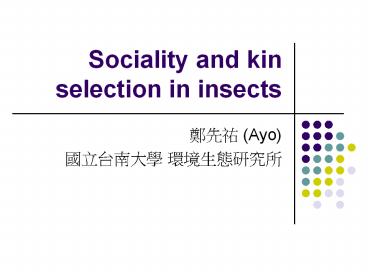Sociality and kin selection in insects - PowerPoint PPT Presentation
1 / 19
Title:
Sociality and kin selection in insects
Description:
Sociality and kin selection in insects (Ayo) Contents 9.1 introduction 9.2 The origin and evolution of eu-sociality ... – PowerPoint PPT presentation
Number of Views:191
Avg rating:3.0/5.0
Title: Sociality and kin selection in insects
1
Sociality and kin selection in insects
- ??? (Ayo)
- ?????? ???????
2
Contents
- 9.1 introduction
- 9.2 The origin and evolution of eu-sociality
(????) - 9.3 The evolution of a stable reproductive skew
- 9.4 Sex ratio evolution and kin conflict in
social insects - 9.5 conclusion
3
9.1 Introduction
- Eusocial society(???????) alongside cooperative
care of the brood and an overlap of adult
generations, exhibit a reproductive division of
labour (???????). - Some members are specialized for reproduction
(queens or kings), whereas others devote
themselves to foraging, nest construction,
defence and brood-reaing. - Reproductive altruism (??????)
4
Eusocial insects
- Most eusocial insects belong to two orders, the
Hymenoptera (???) (ants, bees and wasps) and the
Isoptera (termites) (??). - All ants and termites are eusocial, but many bees
and wasps are solitary or exhibit other grades of
social organization. - A number of aphids (Hemiptera) are arguably also
eusocial, as are some beetles and thrips. - Table 9.1 The major groups of eusocial insects
and their traits.
5
Hamiltons rule
- Hamiltons theory of kin selection.
- the evolution of altruism and sociality
- Hamiltons rule, the gene for altruism undergoes
selection if the condition r1b - r2c gt 0 is
satisfied. - r1 is the altruists relatedness to the
beneficiarys offspring (?????) x b(???) - r2 is the altruists relatedness to its own
offspring. (????????) x c (???)
6
- West-Eberhard (1975), ? Hamiltons rule ??? if rb
c gt 0, where r is the relatedness of the
altruist to the beneficiary. - Table 9.2 Relatedness levels in a social insect
colony.
7
9.2 The origin and evolution of eusociality
- 9.2.1 The necessity of kin selection
- 9.2.2 Hymenopteran eusociality and the
haplodiploidy(????) hypothesis - 9.2.3 The origin of eusociality in the termites
8
The necessity of kin selection
- Reciprocal altruism(????) is not true
altruism. - Eusociality usually entails true altruism
(?????). - Hamiltons rule shows that both genetic factors
(affecting relatedness) and ecological ones
(affecting benefit and cost) must be important in
promoting eusocial evolution. - Eusocial evolution Mutualism hypothesis vs.
parental manipulation hypothesis
9
Hymenopteran eusociality and the haplodiploidy
hypothesis
- Eusociality has evolved independently many times
among the insects. - Wilson (1971) estimated that there have been 11
origins of eusociality in the Hymenoptera, and
one in the termites. - A phylogeny based on mitochondrial DNA sequences
suggests that the aphid family Hormaphididae
evolved a a soldier caste at least five times.
10
Relatedness levels in the Hymenoptera
- Males are haploid and develop from unfertilized
eggs, but females are diploid and develop from
fertilized eggs. (haplo-diploidy) - ??,?? ? relatedness ????
- Haplo-diploidy hypothesis
11
(No Transcript)
12
9.3 The evolution of a stable reproductive skew
- Skew theory suggest several factors of this type.
- Fig. 9.2 factors affect the stable level of
reproductive skew. - ?? reproductive skew???Group productivity,
ecological constraints, relatedness - ????? subordinate fighting ability
13
Skew evolution in the polistine wasps
- Reeve and Nonacs (1992) Polistes fuscatus wasps,
skew reproduction, ?????,alpha, beta - ?????? eggs
- Alpha queens showed no consistent response to egg
removal, but beta ones became more aggressive on
average.
14
Skew evolution in the leptothoracine ants
- Bourke and Heinze (1994), polygynous colonies
live in extended uniform habitats such as
pinewoods. - Cost of dispersal are therefore relatively low.
- All queens lay eggs and live together peaceably.
(skew is low) - Monogynous colonies live in a rocky area.
- Cost of dispersal is high.
- Permanently wingless, only one queen.
15
9.4 Sex ratio evolution and kin conflict in
social insects
- Relatedness asymmetry relateness to systers /
relatedness to brothers - 0.75/0.25 31 (Table 9.2)
- Sex ratio 31 in favour of females.
- Tests of sex ratio theory in social Hymenoptera
- Table 9.4 Tests of sex ratio theory within
monogynous, non-parasitic ant species. - Population sex investment ratio
????????(gt0.5),?????? (0.36)
16
- Some colonies at mother-daughter associations
should produce female-biased broods. - Sundstrom (1994), monogynous population of wood
ant (Formica truncorum), using allozyme analysis. - Some colonies had a multiply mated queen,
produced mostly males - Others had a singly mated queen produced mainly
females.
17
How workers manipulate sex allocation
- Sundstrom et al. (1996) shown that all queens in
a monogynous population of Formica exsecta
contributed a similar fraction of haploid eggs to
their colonys egg pool. - However, workers in colonies headed by singly
mated queens raised a female bias of adult
sexuals, - Whereas workers under multiply mated queens
raised a male bias.
18
9.5 conclusion
- Two unsolved issues
- The adaptive significance of within-colony kin
discrimination - The evolution of multiple mating.
19
?????
http//mail.nutn.edu.tw/hycheng































